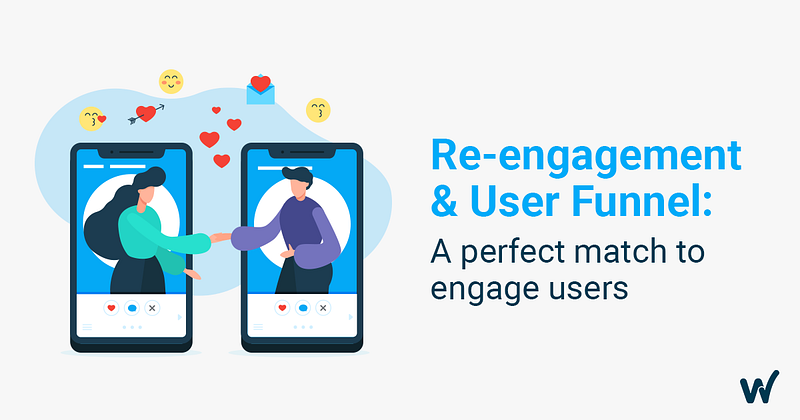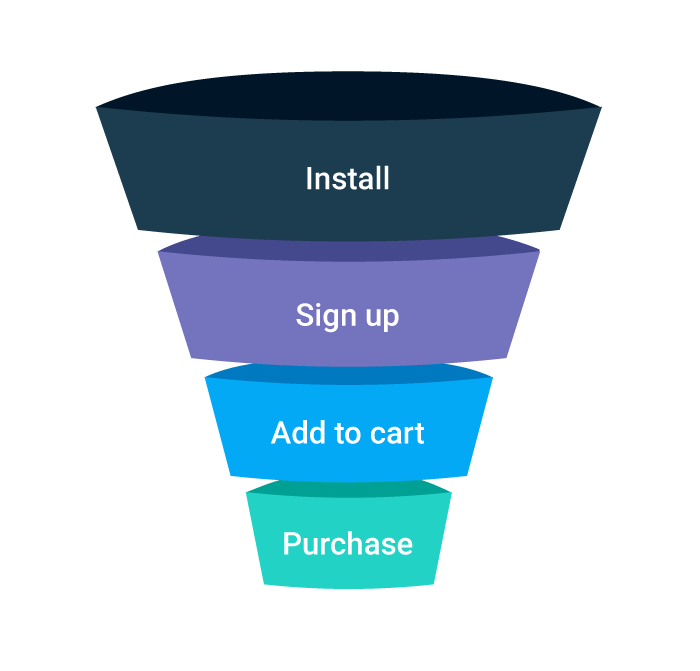Running UA strategies is good to acquire new customers, but they aren’t enough to make them love you.
That’s why companies are desperately looking for platonic love coming from engaged users.
Have you ever run a re-engagement campaign or are you planning to?

In this post, I’ll share how you can make your re-activation efforts more effective, understanding why Re-Engagement and User funnel make one of the most perfect love matches in the mobile world.
Mobile re-engagement strategies look to re-active users who uninstalled an app in the past or haven’t access for a certain period of time.
It sounds like a strategy that every app should apply, but not all business models are fittable for it. If your users have a low Life-Time Value (LTV), it makes no sense doing an effort to re-engage them, it would be a bad spend that you might never recover.
Understanding your User Funnel
Analyzing the user funnel, on the other hand, is recommended to every app. A user funnel is basically a way of understanding the steps required for a consumer to perform a certain action within the app.

Having your user funnel well mapped and knowing all the steps of it to get to your main conversion is key to improve your product and re-engagement campaigns.
Once you have created the different funnels, you can easily recognize which steps you are losing most of your users. With this information, you can start creating different hypotheses on what might be happening. Is the UX of my app not that good? Is this step really difficult to advance or there something that is not working? Should I consider changing this step of the funnel?
Create and test several hypotheses so you can improve your conversion.
Making your Customer Journey Easier
Another important thing is the Conversion Rate (CR) of the event funnel.

Knowing the conversion rate between each step to the other gives you a great overview of where you should be working harder to improve. Those CR’s also could be taken as benchmarks when you are running a user acquisition campaign as a base for optimization or as a feedback to your media source.
Analyzing the CR’s is crucial when you are defining what is going to be your re-engagement goal. Re-engagement campaigns are great on giving last push to the users, so they can perform a certain type of action leading a raise on the CR of this defined event.
Trusting Data
Be sure that your integration is being well tracked, dirty metrics can be your worst nightmare and lead you to wrong decisions. Always check with your tech team that all tracking events are well implemented and measurement is being properly done.
Tracking as many events on your app as you can, gives you a detailed view of your user’s behavior. It might cost you much budget and can be complex to your tech team to implement. But, the higher is the granularity of your data, the deeper turns to be your analysis and more accurate on your decisions and actions you’ll be.
Defining your Target Audience
After you’ve built different user funnels, checked the correct implementation of your tracking, analyzed your CR’s and the whole user journey, the big question is: Who should be the audience of my re-engagement campaigns?
Actually, there is no perfect audience. What I suggest you to do is to segment all your users based on their behavior. How do you understand their behavior? Understanding your user funnel. That’s why I like to say re-engagement and user funnel are a perfect marriage. One cannot exist without the other.
There is no limitation on segmenting your users and creating your audience, it will only depend on what you want to achieve: a purchase, a login, a registration… Remember always to create an audience list with at least 250,000 users, otherwise, it can be very expensive to reach them and the results might not be positive.
Also, keep in mind that you don’t need to wait for users to stop using your app or uninstall it to start checking your retention rates and avoid them from dropping off early. Targeting active users is recommended to prevent this from happening.
Before setting up a re-engagement campaign let’s think it as a relationship! As for a couple to work you need to understand each other, in Re-engagement you need to look over your user funnel to comprehend. A couple needs to take care of each other, and your users need an easy customer journey, remember to optimize every step. A couple needs trust, and so do you to rely on your data. Continuously check that all your events are being tracked correctly. All couples every now and then need to try something new otherwise, the relationship gets cold, so you might want to vary your strategy to re-activate your audience.
To know more about how you can make your couple work, talk to one of our Growth Experts.

Recent Comments